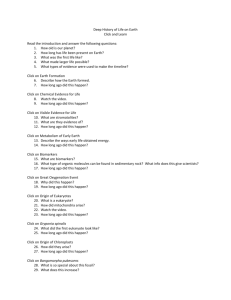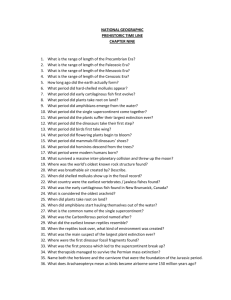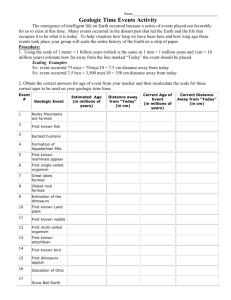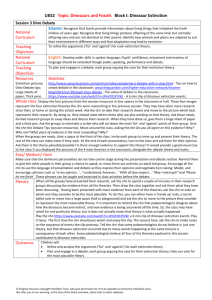Session 02 - Hamilton Trust
advertisement
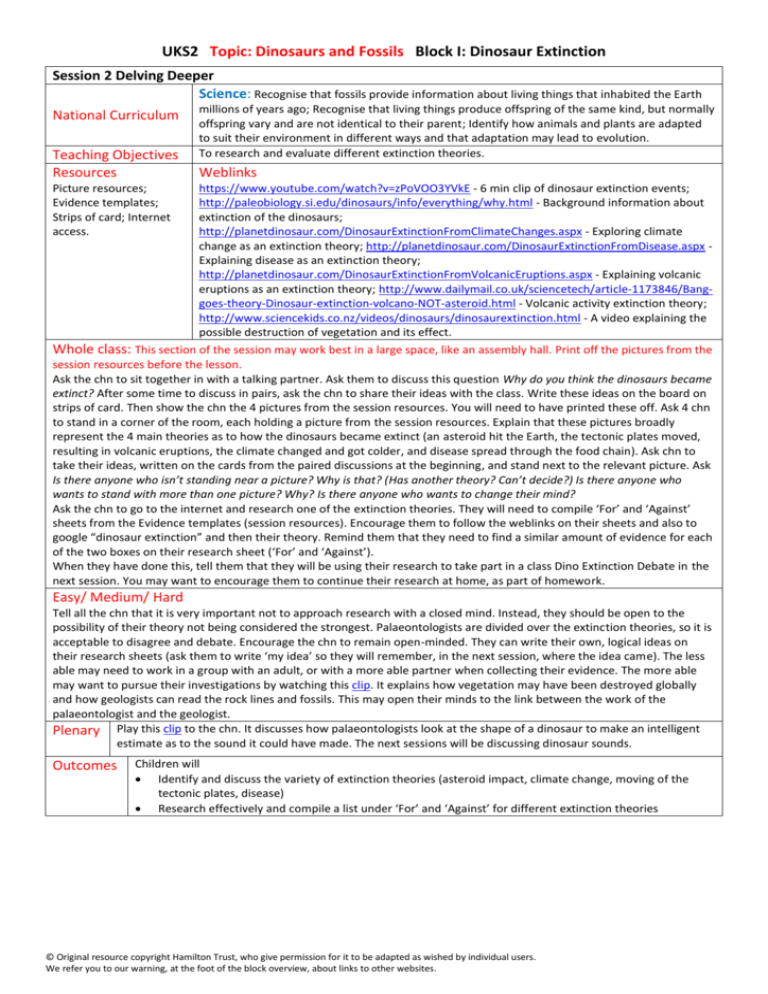
UKS2 Topic: Dinosaurs and Fossils Block I: Dinosaur Extinction Session 2 Delving Deeper Science: Recognise that fossils provide information about living things that inhabited the Earth National Curriculum Teaching Objectives Resources millions of years ago; Recognise that living things produce offspring of the same kind, but normally offspring vary and are not identical to their parent; Identify how animals and plants are adapted to suit their environment in different ways and that adaptation may lead to evolution. To research and evaluate different extinction theories. Weblinks Picture resources; Evidence templates; Strips of card; Internet access. https://www.youtube.com/watch?v=zPoVOO3YVkE - 6 min clip of dinosaur extinction events; http://paleobiology.si.edu/dinosaurs/info/everything/why.html - Background information about extinction of the dinosaurs; http://planetdinosaur.com/DinosaurExtinctionFromClimateChanges.aspx - Exploring climate change as an extinction theory; http://planetdinosaur.com/DinosaurExtinctionFromDisease.aspx Explaining disease as an extinction theory; http://planetdinosaur.com/DinosaurExtinctionFromVolcanicEruptions.aspx - Explaining volcanic eruptions as an extinction theory; http://www.dailymail.co.uk/sciencetech/article-1173846/Banggoes-theory-Dinosaur-extinction-volcano-NOT-asteroid.html - Volcanic activity extinction theory; http://www.sciencekids.co.nz/videos/dinosaurs/dinosaurextinction.html - A video explaining the possible destruction of vegetation and its effect. Whole class: This section of the session may work best in a large space, like an assembly hall. Print off the pictures from the session resources before the lesson. Ask the chn to sit together in with a talking partner. Ask them to discuss this question Why do you think the dinosaurs became extinct? After some time to discuss in pairs, ask the chn to share their ideas with the class. Write these ideas on the board on strips of card. Then show the chn the 4 pictures from the session resources. You will need to have printed these off. Ask 4 chn to stand in a corner of the room, each holding a picture from the session resources. Explain that these pictures broadly represent the 4 main theories as to how the dinosaurs became extinct (an asteroid hit the Earth, the tectonic plates moved, resulting in volcanic eruptions, the climate changed and got colder, and disease spread through the food chain). Ask chn to take their ideas, written on the cards from the paired discussions at the beginning, and stand next to the relevant picture. Ask Is there anyone who isn’t standing near a picture? Why is that? (Has another theory? Can’t decide?) Is there anyone who wants to stand with more than one picture? Why? Is there anyone who wants to change their mind? Ask the chn to go to the internet and research one of the extinction theories. They will need to compile ‘For’ and ‘Against’ sheets from the Evidence templates (session resources). Encourage them to follow the weblinks on their sheets and also to google “dinosaur extinction” and then their theory. Remind them that they need to find a similar amount of evidence for each of the two boxes on their research sheet (‘For’ and ‘Against’). When they have done this, tell them that they will be using their research to take part in a class Dino Extinction Debate in the next session. You may want to encourage them to continue their research at home, as part of homework. Easy/ Medium/ Hard Tell all the chn that it is very important not to approach research with a closed mind. Instead, they should be open to the possibility of their theory not being considered the strongest. Palaeontologists are divided over the extinction theories, so it is acceptable to disagree and debate. Encourage the chn to remain open-minded. They can write their own, logical ideas on their research sheets (ask them to write ‘my idea’ so they will remember, in the next session, where the idea came). The less able may need to work in a group with an adult, or with a more able partner when collecting their evidence. The more able may want to pursue their investigations by watching this clip. It explains how vegetation may have been destroyed globally and how geologists can read the rock lines and fossils. This may open their minds to the link between the work of the palaeontologist and the geologist. Plenary Play this clip to the chn. It discusses how palaeontologists look at the shape of a dinosaur to make an intelligent estimate as to the sound it could have made. The next sessions will be discussing dinosaur sounds. Outcomes Children will Identify and discuss the variety of extinction theories (asteroid impact, climate change, moving of the tectonic plates, disease) Research effectively and compile a list under ‘For’ and ‘Against’ for different extinction theories © Original resource copyright Hamilton Trust, who give permission for it to be adapted as wished by individual users. We refer you to our warning, at the foot of the block overview, about links to other websites.

